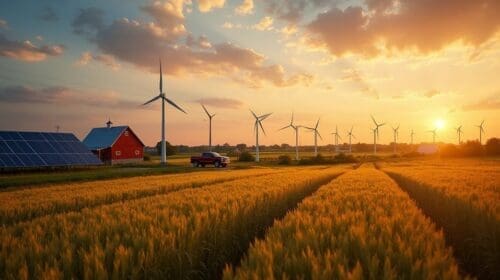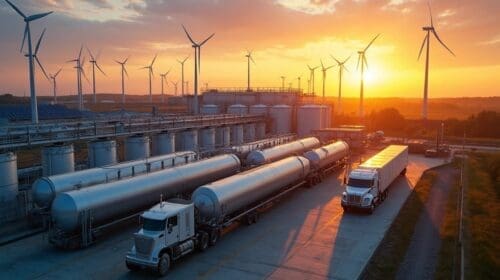Nuclear energy stands at a critical crossroads in the global power landscape. As countries worldwide seek solutions to combat climate change while meeting growing energy demands, nuclear power has emerged as a significant topic in discussions about future energy systems. The industry faces both unprecedented opportunities and complex challenges that will shape its role in the coming decades.
This analysis examines nuclear energy trends and their implications for global power generation through 2050. We explore the current state of nuclear power worldwide, evaluate key growth drivers, including technological innovations and policy support, address persistent challenges, and analyze expert projections for the industry’s future. Special attention is given to emerging technologies like small modular reactors and their potential impact on the nuclear sector’s evolution.
Current State of Global Nuclear Power
The global nuclear power landscape encompasses a vast network of operational facilities providing consistent baseload power across multiple continents. Currently, nuclear power generates 2,602 TWh of electricity annually, accounting for approximately 9% of global electricity production.
Nuclear’s share of global electricity generation
The contribution of nuclear power varies significantly by region, with some countries heavily dependent on nuclear generation. France leads with nuclear power, providing 68.5% of its electricity, while Slovakia and Hungary maintain approximately half of their power generation from nuclear sources. The United States remains the largest producer of nuclear power, generating nearly 790 billion kilowatt-hours annually, representing about 19.5% of its total electricity production.
Operating reactors and capacity by region
The current global nuclear fleet consists of approximately 440 operational reactors across 32 countries and Taiwan, with a combined capacity of 390 GWe. The distribution of nuclear capacity shows significant regional variations:
| Country | Annual Generation (BkWh) | Nuclear Share |
|---|---|---|
| United States | 789.88 | 19.5% |
| France | 379.50 | 68.5% |
| China | 366.30 | 4.8% |
| Russia | 215.75 | 21.0% |
| South Korea | 152.33 | 27.7% |
Recent trends in nuclear power plant construction
The nuclear industry has experienced significant developments in recent construction activities:
- Approximately 60 power reactors are currently under construction across 16 countries
- Most new construction projects are concentrated in Asian nations
- Over the past two decades, 107 reactors were retired while 100 new units began operation
- About 90 additional reactors are in the planning phase, with over 300 more proposed
The industry’s growth is particularly pronounced in Asia, where rapidly expanding economies and increasing electricity demand drive nuclear power development. Countries like China and India are leading this expansion, while established nuclear nations focus on maintaining and upgrading existing facilities. The emergence of new nuclear technologies, particularly small modular reactors (SMRs), represents a significant shift in construction trends, with several countries exploring these advanced designs for future deployment.
Drivers of Future Nuclear Energy Growth
Several powerful forces are driving the renewed interest in nuclear energy development worldwide. These drivers are reshaping the industry’s trajectory and influencing investment decisions across the global energy sector.
Climate change mitigation goals
Nuclear power occupies a unique position in addressing global climate change as the only carbon-free energy source currently contributing significantly to world energy supplies. The technology already displaces approximately 1.6 gigatonnes of carbon dioxide emissions annually. Meeting the Paris Agreement’s target of limiting global warming to 1.5°C requires nuclear capacity to triple to 1,160 gigawatts by 2050. Without nuclear energy, achieving climate targets would cost an estimated $1.6 trillion more globally, according to International Energy Agency assessments.
Energy security concerns
Recent global events, including supply chain disruptions and geopolitical tensions, have heightened focus on energy security. Nuclear power offers distinct advantages in this context:
- Fuel storage capacity of up to two years on-site
- Reduced dependency on fossil fuel imports
- Continuous operation capability (24/7/365)
- Resilience against extreme weather events
- Enhanced grid stability and reliability
Technological advancements in reactor designs
Innovation in nuclear technology is accelerating, particularly in the development of small modular reactors (SMRs). These advanced designs offer significant improvements over traditional reactors:
| Feature | Benefit |
|---|---|
| Modular Construction | Reduced building time and costs |
| Scalable Design | Flexible power output options |
| Enhanced Safety | Advanced passive safety systems |
| Versatile Applications | Industrial heat, desalination, hydrogen production |
Government policies and support
Governments worldwide are implementing supportive policies to accelerate nuclear development. The U.S. has invested billions in nuclear energy advancement through initiatives like the Infrastructure Investment and Jobs Act, which allocated $6 billion for existing plant support and $2.4 billion for advanced reactor development. Similar support mechanisms are emerging globally, with countries like France, China, and the UK establishing ambitious nuclear expansion programs.
The combination of climate urgency, energy security imperatives, technological innovation, and policy support is creating unprecedented momentum for nuclear energy growth. These drivers are particularly significant in developing economies, where rapid industrialization and increasing electricity demand intersect with decarbonization goals.
Challenges Facing Nuclear Energy Expansion
Despite the promising outlook for nuclear energy expansion, the industry faces substantial obstacles that could impede its growth trajectory. These challenges range from economic constraints to public acceptance issues, requiring careful consideration and innovative solutions.
High upfront costs and financing difficulties
The economics of nuclear power present significant hurdles for new projects. Nuclear plants require capital investments of $6-9 billion for standard reactors, with construction periods extending beyond five years before generating any revenue. These financial characteristics create unique challenges:
| Cost Component | Impact on Project Viability |
|---|---|
| Initial Capital | 60-80% of total lifetime costs |
| Construction Time | 5-7 years average duration |
| Interest Charges | Compound significantly during construction |
| Risk Premium | Higher financing costs due to project complexity |
Public perception and safety concerns
Historical incidents continue to influence public attitudes toward nuclear energy. Three major accidents—Three Mile Island, Chernobyl, and Fukushima—have significantly impacted public confidence. Key concerns include:
- Operational safety and accident risks
- Emergency preparedness and evacuation plans
- Potential terrorist threats to facilities
- Health impacts on surrounding communities
Support for nuclear energy correlates strongly with knowledge and experience, with countries already utilizing nuclear power showing higher acceptance rates. However, rebuilding public trust requires sustained efforts in transparency and safety demonstration.
Waste management issues
Nuclear waste disposal represents a persistent challenge for the industry. Currently, over 250,000 tons of highly radioactive waste are stored across 14 countries, requiring management for tens of thousands of years. The industry faces several critical issues:
The cost of waste management adds approximately $500 million annually to operational expenses in the United States alone. Finland’s pioneering deep geological repository, costing €2.6 billion, represents the first permanent solution attempt, though concerns about long-term viability persist.
Competition from other low-carbon energy sources
The rapidly evolving energy landscape presents competitive challenges for nuclear power. According to recent data, the levelized cost of energy (LCOE) for new nuclear plants ranges from $112 to $189 per MWh, significantly higher than alternatives:
- Onshore wind: $29-56 per MWh
- Utility-scale solar: $36-46 per MWh
- Natural gas (combined cycle): $44-73 per MWh
These cost differentials, combined with shorter construction times for renewable alternatives, create substantial market pressure against nuclear expansion. Additionally, the flexibility of renewable technologies in meeting variable demand poses a competitive advantage over nuclear’s baseload generation model.
The regulatory environment further compounds these challenges, with constantly evolving safety requirements often necessitating design modifications during construction. For instance, post-9/11 aircraft strike resistance requirements led to significant cost increases and delays in recent projects, including the Vogtle plant expansion in Georgia.
Projections for Nuclear Power Through 2050
Recent projections from major international organizations paint an ambitious picture for nuclear power’s expansion through mid-century. The latest forecasts reflect growing recognition of nuclear energy’s role in achieving global energy security and climate objectives.
IEA and IAEA forecasts for nuclear capacity growth
The International Atomic Energy Agency (IAEA) has revised its nuclear power projections upward for the fourth consecutive year. From the current global capacity of 371.5 GW(e), operating across 413 reactors, the IAEA projects two distinct scenarios:
- High Case Scenario: 950 gigawatts by 2050 (2.5 times current capacity)
- Low Case Scenario: 514 gigawatts by 2050 (40% increase)
These projections represent a significant upward revision, with the high case scenario showing a 24% increase compared to forecasts made just three years ago. The increased projections align with growing global consensus on accelerating nuclear deployment for deep decarbonization.
Regional trends in nuclear power development
Nuclear power development shows distinct regional patterns through 2050:
| Region | Development Focus | Projected Growth |
|---|---|---|
| Asia | New construction | Highest (60% of additions) |
| Europe | Fleet modernization | Moderate |
| North America | Life extensions | Steady |
| Middle East | New market entry | Rapid growth |
China continues to lead global expansion, accounting for approximately 60% of all new additions since 2000. The country’s nuclear program has demonstrated remarkable growth, rising from minimal capacity to become the world’s third-largest producer. Meanwhile, approximately 30 newcomer countries are actively considering or implementing plans to introduce nuclear power into their energy mix.
Role of small modular reactors (SMRs)
Small modular reactors are projected to play an increasingly significant role in nuclear power’s future. The IAEA forecasts that SMRs will account for:
- 25% of added capacity in the high case scenario
- 6% of added capacity in the low case scenario
Nearly 80 SMR designs are under development globally, with several approaching commercial deployment. The first commercial SMR began operation in China in late 2023, marking a significant milestone in next-generation nuclear technology. Countries, including the United States, Canada, and the United Kingdom, have implemented specific policy support mechanisms to accelerate SMR deployment.
Nuclear’s potential contribution to decarbonization goals
Nuclear power’s contribution to global decarbonization efforts through 2050 is expected to be substantial. The technology has already avoided approximately 70 gigatonnes of CO2 emissions over the past five decades. Looking ahead, nuclear power is projected to:
- Provide 7.8% of global electricity generation by 2050
- Avoid 1.5 gigatonnes of annual CO2 emissions
- Reduce natural gas demand by 180 billion cubic meters annually
- Support grid stability with increasing renewable penetration
Investment requirements for achieving these projections are significant, with annual investment needs reaching $125 billion by the late 2020s, more than triple recent levels. This scaling up depends on enabling factors including supportive national policies, enhanced investment frameworks, successful demonstration projects, and regulatory harmonization—particularly for SMRs.
The achievement of these projections relies heavily on policy decisions made in the coming years. At the United Nations Climate Change Conference (COP28), nuclear power was included for the first time in the Global Stocktake, marking increased recognition of its role in deep decarbonization efforts. This policy support, combined with technological advancement and growing energy security concerns, suggests a potentially transformative period for nuclear power through 2050.
Conclusion
Nuclear power’s trajectory through 2050 reflects a complex interplay of technological advancement, policy support, and market forces. IAEA projections suggesting potential capacity growth up to 950 gigawatts demonstrate nuclear energy’s expanding role in global power generation. Small modular reactors represent a particularly promising development, offering solutions to traditional nuclear power challenges while opening new deployment possibilities across diverse markets.
Nuclear energy’s contribution extends beyond power generation, positioning the technology as a crucial component of global decarbonization efforts. Projected annual emissions reductions of 1.5 gigatonnes highlight nuclear power’s significant environmental impact, while enhanced energy security benefits strengthen its strategic importance. Success depends on sustained policy support, continued technological innovation, and effective solutions to persistent challenges, particularly regarding costs and public acceptance.
Oil and gas operations are commonly found in remote locations far from company headquarters. Now, it's possible to monitor pump operations, collate and analyze seismic data, and track employees around the world from almost anywhere. Whether employees are in the office or in the field, the internet and related applications enable a greater multidirectional flow of information – and control – than ever before.



![Why Enhanced Geothermal Energy Could Be Your Next Smart Investment [2025 Guide]](https://b1006343.smushcdn.com/1006343/wp-content/uploads/2025/06/Why-Enhanced-Geothermal-Energy-Could-Be-Your-Next-Smart-Investment-2025-Guide-500x280.jpg?lossy=2&strip=1&webp=1)





